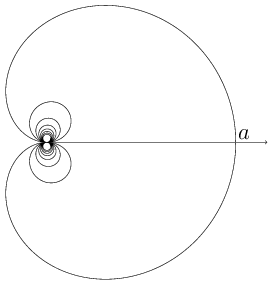Cochleoid
From Encyclopedia of Mathematics
The printable version is no longer supported and may have rendering errors. Please update your browser bookmarks and please use the default browser print function instead.

Figure 1. The cochleoid (pdf)
A plane transcendental curve whose equation in polar coordinates is \begin{equation} \rho = a\frac{\sin\varphi}{\varphi}. \end{equation}
The cochleoid has infinitely many spirals, passing through its pole and touching the polar axis (see Fig.). The pole is a singular point of infinite multiplicity. Any straight line through the pole $O$ intersects the cochleoid; the tangents to the cochleoid at these intersection points pass through the same point.
The inverse of the cochleoid with respect to the origin is the quadratrix of Hippias.
References
| [1] | A.A. Savelov, "Planar curves" , Moscow (1960) (In Russian) |
| [a1] | J.D. Lawrence, "A catalog of special plane curves" , Dover (1972) ISBN 0-486-60288-5 Zbl 0257.50002 |
How to Cite This Entry:
Cochleoid. Encyclopedia of Mathematics. URL: http://encyclopediaofmath.org/index.php?title=Cochleoid&oldid=54740
Cochleoid. Encyclopedia of Mathematics. URL: http://encyclopediaofmath.org/index.php?title=Cochleoid&oldid=54740
This article was adapted from an original article by D.D. Sokolov (originator), which appeared in Encyclopedia of Mathematics - ISBN 1402006098. See original article